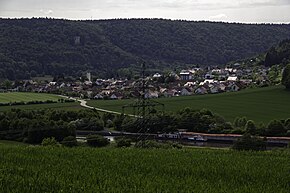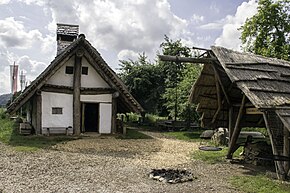Töging (Dietfurt an der Altmühl)
|
Töging
City of Dietfurt an der Altmühl
Coordinates: 49 ° 1 ′ 24 ″ N , 11 ° 33 ′ 45 ″ E
|
|
|---|---|
| Height : | 369 (361-415) m |
| Residents : | 1131 (Dec. 30, 2019) |
| Incorporation : | July 1, 1972 |
| Postal code : | 92345 |
| Area code : | 08464 |
|
Töging Castle with a war memorial
|
|
Töging ( Bavarian Deching ) is a district of the city of Dietfurt an der Altmühl in the district of Neumarkt in the Upper Palatinate , administrative region of Upper Palatinate .
location
The place is in the southern Franconian Alb in the Altmühltal on the state road 2230 southwest of the municipality seat Dietfurt an der Altmühl. After Töging, the Altmühl will be transferred to the Rhine-Main-Danube Canal .
history
There are more than 30 prehistoric burial mounds in the Tögings corridor.
In Töging (Tegeningen = Bavarian clan settlement of the Tagino, Tegeno or Tegno), the Eichstatt Bishop Gundekar II consecrated a church around 1058 . Another early mention of Töging can be found in a document from 1080, with which King Heinrich IV gave the Eichstätter Bishop Udalrich I the ban on wild animals in an area on whose eastern border Töging was. Presumably as a result of this wild ban, the bishop came to the state sovereignty, which was recognized on October 19, 1305 in the Gaimersheimer Spruch as part of the Hirschberg inheritance by the Bavarian dukes; in this document the place is called Tegningen.
Landlords and feudal lords were the local nobles; they often divided property. Two of these aristocrats, Hadmar and Wernher von Töging, appear in 1122 as ministerials to the Eichstätter bishop. In 1131 Heinrich von Töging, another Heinrich and Sigebot von Töging appear as documentary witnesses - so there were two local noble families at that time. Other Tögingen aristocrats are known by name from the 12th century who belonged to at least three families. 1198 Ulrich von Töging and his father are named as ministerials of the Eichstätter bishop. From an unknown point in time, Tögingen aristocrats became gifts from the Counts of Hirschberg ; so in 1245 Albertus Pincerna appears as "Schenk de Thegeningen". From the other noble family (?) A Gotfridus de Tigingen is mentioned in 1259. The castle of the taverns, which has been preserved, is located at today's parish church of St. Bartholomew , the second, abandoned noble seat at St. At the beginning of the 17th century, people still knew about this castle, which was owned by the Angelbergers in the 14th century , probably through marriage into the tavern family. In 1345 Mechtildis, the "Tögingerin", donated a farm to the Benedictine monastery in Plankstetten . In 1380 a Gebhard Angelberger zu Töging appears in a document; In 1386 he sold four fields at Töging and a tree garden to the taverns. The noble seat then came to the Bechthaler , who sold it to Mathes Schenk around 1415.
For a century it was the taverns in Töging that ruled alone again. Töging's last gift, Mathes, left his heavily indebted property to his son-in-law Eberhard von Ödenberg . In 1517 the Ödenberger was recognized by the Bavarian duke and the Ansbach margrave, and in 1542 by the Eichstätter bishop as a tenant of Tögingen. Ten years earlier, the Ödenberger had obtained enfeoffment from Emperor Charles V with a neck judgment and a blood ban against the bishop's resistance . His sons Wolf and Valentin shared the rule after him. After them, the property was divided into four, until these owners, in addition to the Ödenbergers Wilhelm and Hans Christoph, also the Hegnenbergers, sold everything to the bishop in 1584 (in 1572 the Ödenbergers had tried in vain to appropriate the high jurisdiction). The bishop placed aristocratic nurses in the now high estates office Töging, which was subordinate to the Oberamt Hirschberg ; In 1588 this office was held by Georg Friedrich von Guttenberg , and in 1607 and 1610 by Hans Martin von Gundelsheim . Later the judge's office was transferred to civil administrators who also acted as casters.
In medieval Töging, other noble estates belonged to the Hegingians (14th century) and the Urachers (until 1414). The Plankstetten monastery had owned an estate in Töging since the second half of the 16th century.
The taverns allowed Jews to settle in Töging . These were expelled in 1445 as from the rest of the Hochstifts area, but were resident in Töging again in the 16th and 17th centuries. A synagogue is mentioned in 1602 (today Beilngrieser Straße 1). In 1680 there were ten Jewish families; In 1697, the Tögingen and all other Hochstift Jews were again expelled from the country by the prince-bishop. Nothing has survived from the Jewish cemetery.
In 1553, Töging referred to itself as a market and towards the end of the century had a school that probably died in the Thirty Years' War and was reopened in 1650 by order of the prince-bishop. Töging was the focus for hop growing in this section of the Altmühltal from an early age .
Ecclesiastically, the place has belonged to the original parish of Kottingwörth since the very beginning . In the middle of the 14th century there is talk of the two churches of St. Mary and Peter and St. Bartholomew. In 1608 Töging became a parish, before there was only one early knife.
With the secularization , the lower bishopric of the prince-bishopric, to which the Oberamt Hirschberg and thus the judge's office Töging belonged, came to Grand Duke Archduke Ferdinand III in 1802 . from Tuscany and 1806 to Bavaria . In 1809 the Töging tax district was formed from Töging, Ottmaring and the Eichelhof . In 1818 this community was dissolved again ; but the Eichelhof still belonged to the now again independent municipality of Töging. In 1820, the Oedhof, which was sold in the second half of the 19th century, was separated from Töging in favor of Kottingwörth. In 1830 Töging had 267 inhabitants in 71 households, and in 1950 there were 549 inhabitants in 85 households. 1863 the entrepreneur bought Johann Baptist Prinstner (1815-1887) from Beilngries the existing brick on, modernized it and shipped its bricks at the nearby Ludwigskanal mainly to Nuremberg . Later they switched to the production of lime . In 1909 the place received a rail connection (Beilngries - Neumarkt in der Oberpfalz); In 1967 the last train on the line that was subsequently abandoned passed the town.
In the course of the Bavarian territorial reform , Töging joined the municipality of Dietfurt an der Altmühl on July 1, 1972 and came from the Upper Palatinate district of Beilngries, which had been in existence since 1879 and now dissolved, to the also Upper Palatinate, now expanded district of Neumarkt in the Upper Palatinate.
Attractions
Tögingen Castle
It is the castle of the taverns near the parish church of St. Bartholomew. The defense of the almost square area consisted of a ditch and a circular wall with bastion-like half towers at the four corners. The castle is a two-wing, three-storey building that joins at right angles; the north-south facing main wing has stepped gables . 1985 the city bought Dietfurt on the Altmühl the castle and restored it to 1993. Probably dating from the 13th century square, from humpback blocks listed dungeon was canceled in 1870; the stone material was used in road construction.
Ludwig-Danube-Main Canal
The Ludwig-Danube-Main Canal , which was built between 1835 and 1846 and closed in 1950, passed near Töging . At Töging there was a loading point (annex) for cargo handling . When the Main-Danube Canal was built in the 1990s, however, the Ludwig Canal was largely reshaped. A small section and lock 14 with the restored lock keeper's house have been preserved.
Catholic churches
- St. Peter , consecrated by Gundekar II around 1058, early Gothic, located near the Angelberger Castle, was referred to in 1602 as the "ancient parish church". In terms of type, it is a "choir tower church" with a tower in the east. In 1625 it was so dilapidated that extensive repairs were required; a high altar consecration is attested for 1688. It was changed in the 18th century: in 1707 the tower was raised by Giovanni Battista Camessina from Obermässing , the choir vault and the nave were also raised. It was used as a cemetery church.
- St. Bartholomew was probably the castle chapel of the taverns (altar consecration in 1415) and was used as a parish church at the latest since the 17th century. It was demolished in 1850 and replaced by a new Romanesque building from 1852–1854 , which was consecrated on May 19, 1867. The baroque furnishings of the previous church were removed during the demolition. The parish belongs to the Dietfurt Parish Association.
Alcmona Adventure Park
The Alcmona (Altmühl) association is building a prehistoric adventure village on the old Ludwig Canal near lock 14. The reconstruction is based on the results of an excavation in 1998.
societies
- Kolping family
- Volunteer firefighter
- Cultural association
- Horticultural Association
- Shooting club
- Sports club
- Warrior and soldier camaraderie
- Hiking club
literature
- Johann Kaspar Bundschuh : Töging . In: Geographical Statistical-Topographical Lexicon of Franconia . tape 5 : S-U . Verlag der Stettinische Buchhandlung, Ulm 1802, DNB 790364328 , OCLC 833753112 , Sp. 559-562 ( digitized version ).
- Friedrich Hermann Hofmann and Felix Mader (editor): The art monuments of Upper Palatinate & Regensburg. XII District Office Beilngries. I. District Court of Beilngries. Munich: R. Oldenbourg Verlag 1908 (reprint 1982), pp. 151-153
- Felix Mader: History of the castle and Oberamt Hirschberg. Eichstätt: Brönner & Daentler 1940, pp. 229-234
- Historical Atlas of Bavaria. (In particular) Franken series I issue 6: Eichstätt . In the digital library of the Bavarian State Library
- Pleikard Joseph Stumpf : Töging . In: Bavaria: a geographical-statistical-historical handbook of the kingdom; for the Bavarian people . Second part. Munich 1853, p. 693 ( digitized version ).
Individual evidence
- ^ Wilhelm Volkert (ed.): Handbook of Bavarian offices, communities and courts 1799–1980 . CH Beck, Munich 1983, ISBN 3-406-09669-7 , p. 557 .
- ↑ nave in the amusement park Alcmona ( Memento of 14 February 2014 Internet Archive )




